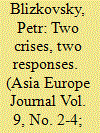| Srl | Item |
| 1 |
ID:
120229


|
|
|
|
|
| Publication |
2013.
|
| Summary/Abstract |
In studying the policy responses to economic crises in ASEAN and the EU, this paper addresses three issues: the financial crisis of 1997-98 in Southeast Asia, and the European Union's financial crisis of 2008 followed by the sovereign debt crisis; policy adjustment actions in both regions in the area of economic coordination; and areas of mutual policy inspiration for both regions.
Both crises studied were regionally risk-intensive. However, their natures were different. The Asian crisis was mainly externally driven by capital flows, while the EU one - especially the sovereign debt part of it - was predominantly of an internal nature due to imbalances in the euro area and a worsening of the situation in public finances in some euro members. On top of it, the pre-crisis economic governance structure differed with a light one in ASEAN and a deeper one in the EU; however, economic policy was still based dominantly on coordination.
The policy adjustment corresponds to the nature of the crisis and original governance structures. In ASEAN, it is characterized somewhat both by a deepening of regional cooperation and a widening of risk-pooling beyond the borders of the region (ASEAN Plus). On the EU side, the policy response privileges a strong deepening of policy cooperation coupled with more narrow-looking geographical coverage.
The crises offer a unique window for policy adjustment. ASEAN could consider: deepening multi-lateralization in the single market; a gradual and low-intensity monetary cooperation; and enhancing its institutional capacity. The EU can, on its side, fully implement its new rules and put them under the EU-27 roof. It can go beyond this and consider a broader economic partnership with some of the new instruments with the EFTA countries. Finally, it can also reflect on the ASEAN success with the enlargement of its regional influence - how to strengthen its leadership in its closest neighbourhood (Balkans, North Africa, Eastern Partnership) by ensuring an area of stability and prosperity.
|
|
|
|
|
|
|
|
|
|
|
|
|
|
|
|
| 2 |
ID:
111024


|
|
|
|
|
| Publication |
2012.
|
| Summary/Abstract |
The financial crisis of 1997/1998 in Southeast Asia triggered institutional developments inside the Association of Southeast Asian Nations (ASEAN) and beyond. They deepened intra-regional cooperation in the economic area and laid down the foundations for the ambition of creating an ASEAN Economic Community that would allow easier exchanges of productive factors. Concurrently, ASEAN also widened its response in the financial domain by initiating various "ASEAN plus" arrangements to pool risks and address volatility in financial markets. The European Union (EU) was hit by the global financial crisis in 2008 and subsequently by the sovereign debt crisis. The EU response to this has been a deepening of legally binding macroeconomic cooperation and the strengthening of the regulatory framework. On top of this, and contrary to the ASEAN case, the EU 27-Minus initiatives go further towards closer political coordination. In parallel, the legally binding scheme has been adopted to strengthen the stability of the Euro Area. This paper analyses the policy responses in both regions to their respective crises. It aims at understanding the driving forces behind the different policy responses, looking at both the region-specific and the more generic institutional and regulatory responses to the crises.
|
|
|
|
|
|
|
|
|
|
|
|
|
|
|
|